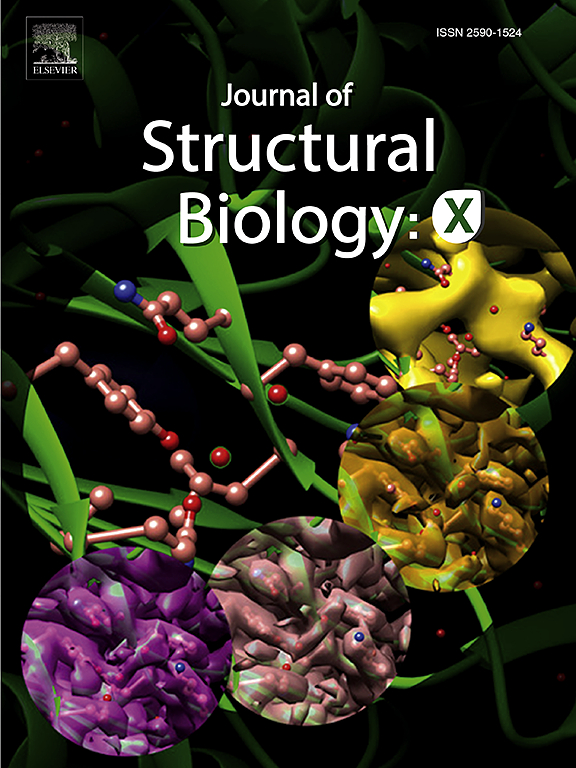草酰乙酸对胞浆内NADP+依赖性异柠檬酸脱氢酶的变构抑制作用。
IF 2.7
3区 生物学
Q3 BIOCHEMISTRY & MOLECULAR BIOLOGY
引用次数: 0
摘要
NADP+依赖性细胞质异柠檬酸脱氢酶(IDH1)通过异柠檬酸的氧化脱羧作用,在氧化应激反应中提供还原能量。由IDH1产生的NADPH是脂肪酸合成的重要辅助因子。IDH1活性的调节对细胞内NADPH的生物学功能至关重要,并且IDH1突变与多种癌症有关。为了确定IDH1的小调控分子,我们确定了小鼠IDH1与异柠檬酸盐和草酰乙酸络合的晶体结构。每个IDH1包括大小结构域,形成活性位点,以及连接两个IDH1分子进行二聚化的扣环结构域。异柠檬酸盐位于镁离子存在的活性位点,而草酰乙酸则位于活性位点之外由两个环结构域形成的新位点。在草酰乙酸的存在下,IDH1的活性降低,在异柠檬酸的加入下无法恢复,表明存在变构调节。IDH1 H170A突变体的活性不受草酰乙酸的影响,该突变体不能在环域结合草酰乙酸。这个变构调节位点可能作为新型IDH1抑制剂的潜在靶点。本文章由计算机程序翻译,如有差异,请以英文原文为准。

Allosteric inhibition of cytosolic NADP+-dependent isocitrate dehydrogenase by oxaloacetate
NADP+-dependent cytosolic isocitrate dehydrogenase (IDH1) plays a crucial role in providing reducing energy in response to oxidative stress through the oxidative decarboxylation of isocitrate. NADPH generated by IDH1 serves as an essential cofactor for fatty acid synthesis. The regulation of IDH1 activity is vital for the biological functions of NADPH within cells, and mutations in IDH1 have been implicated in various cancers. In an effort to identify small regulatory molecules for IDH1, we determined the crystal structures of mouse IDH1 complexed with isocitrate and with oxaloacetate. Each IDH1 comprises large and small domains that form an active site, along with a clasp domain that connects two IDH1 molecules for dimerization. Isocitrate was located at the active site in the presence of a magnesium ion, while oxaloacetate was found at a novel site formed by the two clasp domains, in addition to the active site. The activity of IDH1 was diminished in the presence of oxaloacetate and could not be restored by the addition of isocitrate, indicating the presence of allosteric regulation. The activity of the IDH1 H170A mutant, which is unable to bind oxaloacetate in the clasp domain, was unaffected by oxaloacetate. This allosteric regulatory site may serve as a potential target for novel IDH1 inhibitors.
求助全文
通过发布文献求助,成功后即可免费获取论文全文。
去求助
来源期刊

Journal of structural biology
生物-生化与分子生物学
CiteScore
6.30
自引率
3.30%
发文量
88
审稿时长
65 days
期刊介绍:
Journal of Structural Biology (JSB) has an open access mirror journal, the Journal of Structural Biology: X (JSBX), sharing the same aims and scope, editorial team, submission system and rigorous peer review. Since both journals share the same editorial system, you may submit your manuscript via either journal homepage. You will be prompted during submission (and revision) to choose in which to publish your article. The editors and reviewers are not aware of the choice you made until the article has been published online. JSB and JSBX publish papers dealing with the structural analysis of living material at every level of organization by all methods that lead to an understanding of biological function in terms of molecular and supermolecular structure.
Techniques covered include:
• Light microscopy including confocal microscopy
• All types of electron microscopy
• X-ray diffraction
• Nuclear magnetic resonance
• Scanning force microscopy, scanning probe microscopy, and tunneling microscopy
• Digital image processing
• Computational insights into structure
 求助内容:
求助内容: 应助结果提醒方式:
应助结果提醒方式:


